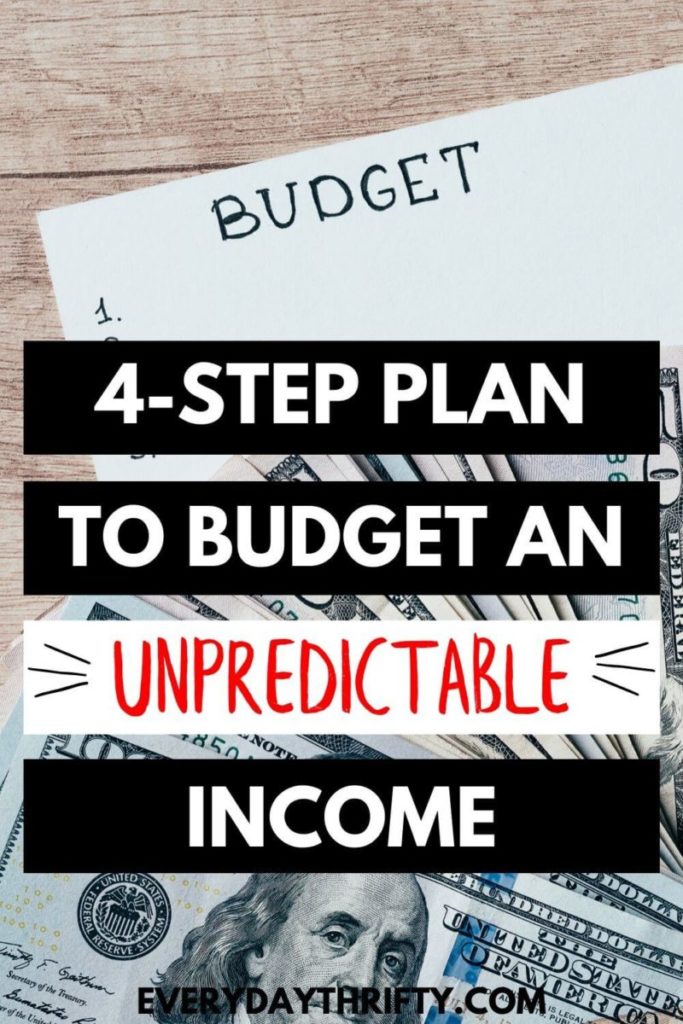How do you budget on an unpredictable income? Most budgeting advice is based on the assumption of a consistent paycheck. But if you’re self-employed or are paid based on commission, your earnings will vary from week to week.
When you work in sales, for example, you experience the cycle of feast and famine. It can make it very difficult to get ahead, let alone stay current with your bills.
Whether you call it irregular income, variable income, or just unpredictable income, it can be difficult to manage. To help you strategize your way to financial success, we’ve put together a simple 4-Step Plan that will help you develop a budget on an unpredictable income and get your finances on track.
This post may contain affiliate links which means that I may receive compensation at no extra cost to you if you make a purchase from a link found on my site. Please review my privacy policy for further details. As an Amazon Associate, I earn from qualifying purchases. Thank you for your support in allowing this site to continue!

Easy 4-Step Plan to Budget on an Unpredictable Income
1. Track Your Expenses
Step One is to begin tracking your expenses so that you know your bottom line. Some of your recurring expenses will be fixed and others will be variable. For your variable expenses, you’ll want to get an average monthly amount.
We recommend looking back at the past 3-6 months to project what your average monthly expenses are. When you’re finished, you should have a pretty good idea of your total projected expenses.
Download our FREE Expense Audit Worksheet to help track your expenses!
2. Track Your Income
Step Two is all about tracking your income! For this step, you need to determine your average income by looking for trends.
Start by totaling your income each month for the past year. Then, look back over the past year, and identify patterns. What trends do you see?
For example, if you’re in sales or own your own business, you may see seasonal patterns such as decreased income in the winter months and increased income during the summer months. The key here is to be aware of and prepare for these types of income trends.
3. Adjust Your Expenses
At this point, you should know your monthly expenses, projected income, and income trends. Let’s go back and look at your worst income month in the past year. Compare that to your expenses. How short was your income from your average monthly expenses?
This is the stage in our 4-Step Plan where we really want to dig into how to budget on an unpredictable income. Being able to weather life’s unpredictability and make progress financially involves preparation and commitment to the process.
The best way to prepare for highs and lows and protect your financial goals from derailment is to build your budget around the worst-case scenario.
If your average monthly expenses are $4000 and on your worst month you made only $2500, do what you can to cut your expenses down to your lowest monthly income. Every little thing you can save adds up and will make your plan easier to implement.
Download our FREE Money Finder Resources to help you creatively cut expenses!
And if you’re struggling to mentally adjust to the idea of cutting back, you should check out 5 Crucial Mental Habits for Living on Less.
4. Create a “Hill and Valley Fund”
The last step to budgeting on an unpredictable income is to create a “Hill and Valley Fund.” This is a fund that allows you to dip into a financial reserve when your unpredictable income is down (valley) and add to it when your income is back up (hill) again.
For example, if your average monthly income is $4000 and on your worst month you only made $2500, then you need to withdraw $1500 from your “Hill and Valley Fund” in your lowest month.
If you make $5000 the following month which would exceed your average monthly income, then you should deposit the excess $1000 into your “Hill and Valley Fund” for potential future needs.
It’s not easy to live on and budget with an unpredictable income. If you’re already in the hole, behind on bills, and struggling with credit cards, then I realize that it may seem like you need something more.
But I want to encourage you that slow and steady wins the race! This method may not make a difference right away, but if you follow these 4 simple steps, then you’ll be able to stop relying on credit to get you through and ringing up late charges that damage your financial goals.





Leave a Reply